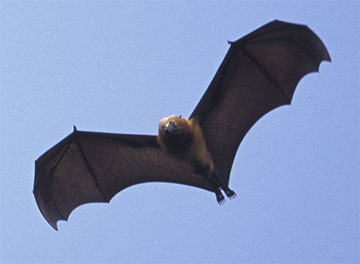Massive bat species returns from the brink of extinction
mongabay.com
October 31, 2008
|
|
A critically endangered bat species has made a dramatic recovery from the brink of extinction, report conservationists.
Down from a handful of individuals in 1989, the Pemba flying fox population on the island of Pemba, off the coast of Tanzania, now stands at more than 22,000. The recovery owes to the efforts of Fauna & Flora International (FFI) and the Department of Commercial Crops, Fruits and Forestry (DCCFF) which established new reserves to protect critical habitat for the species and launched local education initiatives to raise awareness of its plight and reduce hunting. Today local residents take pride in protecting the charismatic species, which is endemic to the island and is one of Africa’s largest bat species (with a wingspan of five-and-a-half feet).
 Bat in flight. Credit E Bowen-Jones FFI |
“Less than twenty years ago this bat looked set to disappear off the face of the planet forever. Thanks to the enthusiasm of local people, FFI’s ongoing conservation efforts have managed to claw this species back from the brink of extinction,” said Joy Juma, FFI East Africa Programme Assistant. “At one time roast bat was a very common dish on Pemba. Now people value the bats for different reasons.”
Community-led “Pemba flying fox clubs”, which help protect the bat through education and monitoring, have been appearing all over the island, according to FFI. Local groups are now looking at ways to use the Pemba flying fox as a draw for ecotourists, although benefits from the conservation of the species extend well beyond tourism — fruit bats play a vital role as seed dispersers and pollinators, especially on islands.